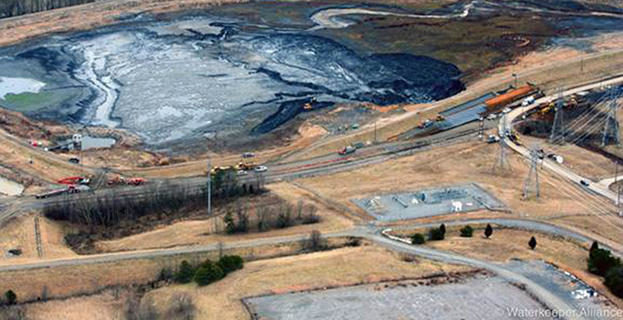
The slow-moving storm which made landfall on Friday as a Category 1 hurricane has dumped record amounts of rain - potentially up to 40 inches in some areas - and continues to flood rivers and highways. In Florence's path are also numerous coal ash ponds from power plants - the waste can contain toxins such as mercury, arsenic, and lead.
As Michael Biesecker of the Associated Press reported:
Duke [Energy] spokeswoman Paige Sheehan said Saturday evening that about 2,000 cubic yards (1,530 cubic meters) of ash, enough to fill roughly 180 dump trucks, have been displaced at the Sutton Plant and that contaminated storm water likely flowed into Sutton Lake, the plant's cooling pond.In a statement Saturday, Duke Energy said "the company does not believe this incident poses a risk to public health or the environment. The company is conducting environmental sampling as well."
The company hasn't yet determined if the weir that drains the cooling pond was open or whether any contamination may have flowed into the swollen Cape Fear River.
The company "will proceed with a full repair as weather conditions improve."
Ahead of the storm, many worried about the threat Florence would pose to human health if it hit the area's coal ash ponds.
The AP's Biesecker notes that "environmentalists have been warning for decades that Duke's coal ash ponds were vulnerable to severe storms and pose a threat to drinking water supplies and public safety."
Duke Energy was instructed to clean up its North Carolina coal ash ponds two years ago, a task that was not completed by the time Florence emerged as a threat to the region.
As the AP reported:
"Unfortunately, Duke Energy has spent years lobbying and litigating and still has not removed the coal ash from its dangerous riverfront pits in the coastal area, some of which are in the floodplain," said Frank Holleman, a senior attorney at the Southern Environmental Law Center who has battled the company in court.Florence's wind speeds have grown less intense as it made landfall on the Carolina coast. Accordingly, the storm has been downgraded from a Category 4 hurricane earlier last week to a Tropical Depression this weekend.
"When a hurricane like Florence hits, we have to hope and pray that our communities do not suffer the consequences of years of irresponsible coal ash practices by the coal ash utilities."
However, the danger Florence posed to the coastal Carolina communities was always going to come from its rainfall and storm surges - and these dangers have not diminished.
The elevated intensity of Florence's rainfall is just one impact of climate change, in which warmer ocean waters lead to stronger and wetter storms. Additionally, elevated sea levels mean that Florence's storm surges will be bigger and move farther inland.
Preliminary reports have suggested that Florence's output has already broken records.
"Hurricane Floyd, which hit North Carolina in 1999, brought 24.06 inches of rain to Wilmington, according to the National Oceanic and Atmospheric Administration (NOAA)," reports the News and Observer. "Unofficial numbers from NOAA show that at least two locations in the state have surpassed that total - and there could be more."
Florence's intense rainfall, coupled with recent policy rollbacks, makes for a risky combination.
Coal ash, the toxic byproduct of burning coal, is the second largest form of waste in the United States, and spills are a perennial concern any time there is a risk of flooding. Coal ash contains elevated levels of pollutants such as arsenic, lead, mercury and radium, which can leach into the groundwater and pose significant environmental dangers, as well as health risks such as cancer and chronic respiratory ailments.
In July, the Trump administration eased the standards for coal ash disposal. As The Hill reported at the time:
Under the amendments made Wednesday [July 18], states or the EPA will be allowed to waive requirements for monitoring groundwater for potential leaching of coal ash under certain circumstances and to issue some certifications that previously had to come from professional engineers.But as the New York Times reported, coal ash - which is typically stored in coal ash ponds - was just one of many environmental dangers that lay in Florence's potential path.
The EPA is also easing acceptable pollution standards for four substances in its groundwater monitoring requirements for coal ash: cobalt, lithium, molybdenum and lead.
There are over 70 "high-priority Superfund hazardous-waste sites" in the Carolinas, including 11 which are being actively monitored by the EPA.
Additionally, the Times reported that "Florence's path includes the two counties, Duplin and Sampson, with the highest concentration of pork production" in the state - and pork production means animal waste typically stored in fecal lagoons which, when flooded, can spread into other waterways and potentially contaminate drinking water.



Comment: Duke Energy has a history of contaminating North Carolina's waterways: